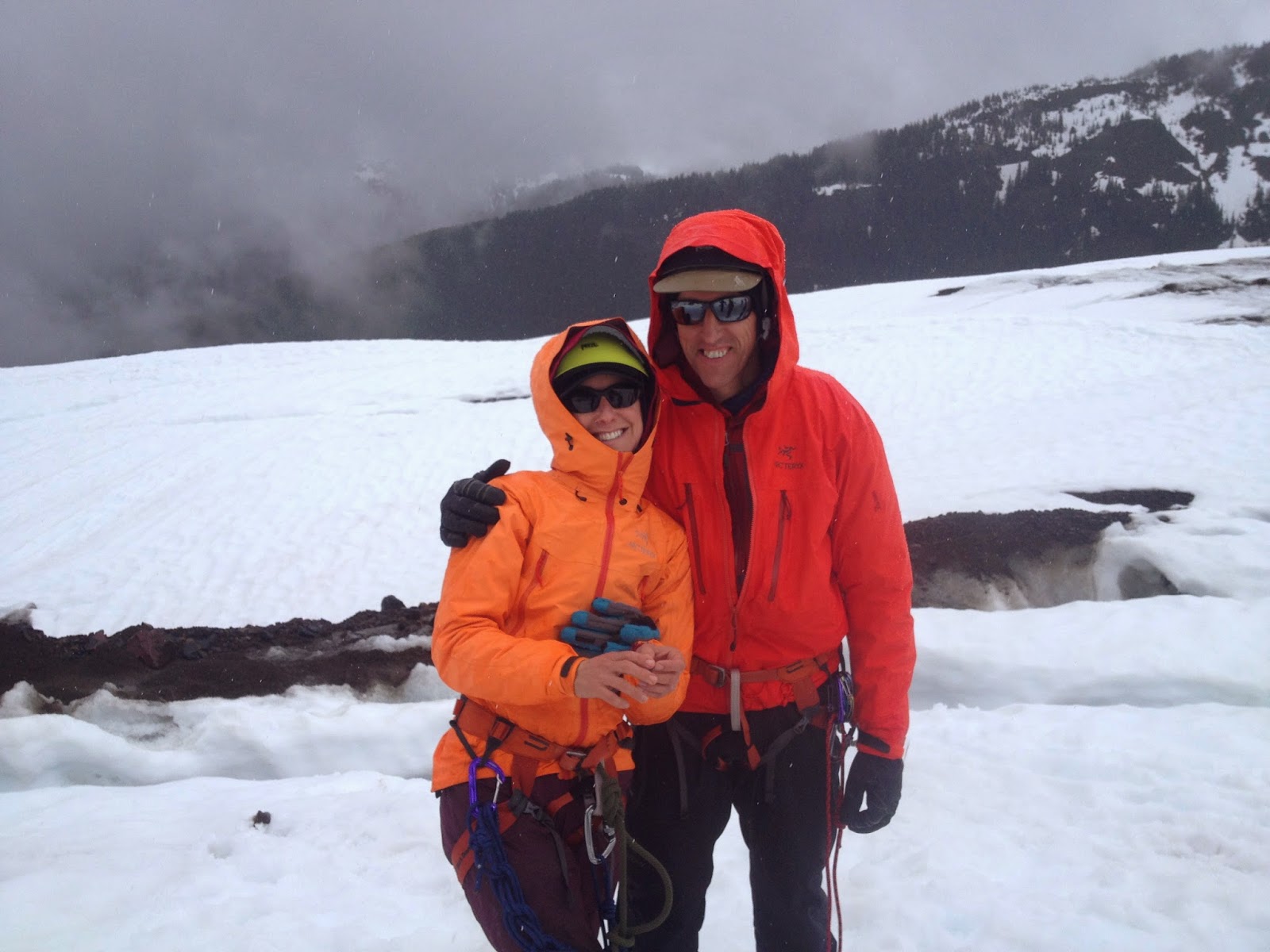After arriving at the trailhead we made a short walk on a good trail to reach our camp. Camp Mirkwood is located at just under 5,000 next to the Coleman Glacier. We had a quick winter camping skills session before heading out to the slopes for snow school. The rest of the afternoon consisted of covering basic skills required to travel on a glacier including; the different ice axe positions, the rest step, kicking steps, self arresting, and team arresting. We also covered the basics of snow anchors and their construction. The long days and close proximity of the slopes to camp allowed us spend ample time working on the different techniques. This set us up perfectly for the following day on the glacier.
Monday, June 2, 2014
Glacier Skills and Crevasse Rescue Course
This past weekend six climbers from around the Northwest
gathered on Mt. Baker to hone their glacier skills. We began the program in the basement of the
AAI world head quarters. These programs
begin with a gear sort and debrief of the itinerary. After going through everybody’s equipment we
loaded the AAI transport vehicle (AAI #1) and headed to the mountains!
After arriving at the trailhead we made a short walk on a good trail to reach our camp. Camp Mirkwood is located at just under 5,000 next to the Coleman Glacier. We had a quick winter camping skills session before heading out to the slopes for snow school. The rest of the afternoon consisted of covering basic skills required to travel on a glacier including; the different ice axe positions, the rest step, kicking steps, self arresting, and team arresting. We also covered the basics of snow anchors and their construction. The long days and close proximity of the slopes to camp allowed us spend ample time working on the different techniques. This set us up perfectly for the following day on the glacier.
After arriving at the trailhead we made a short walk on a good trail to reach our camp. Camp Mirkwood is located at just under 5,000 next to the Coleman Glacier. We had a quick winter camping skills session before heading out to the slopes for snow school. The rest of the afternoon consisted of covering basic skills required to travel on a glacier including; the different ice axe positions, the rest step, kicking steps, self arresting, and team arresting. We also covered the basics of snow anchors and their construction. The long days and close proximity of the slopes to camp allowed us spend ample time working on the different techniques. This set us up perfectly for the following day on the glacier.
On the second day we built more snow anchors and a short rappel down to the glacier. After “landing” on the glacier we discussed
the different methodology of how to rope up.
A short hike on the glacier took us to an ideal classroom for crevasse
rescue. We built two practice stations
for the team and divided in to groups of two.
Each participant got the chance to be rescued as well as the chance to
be the rescuer. Putting actual subjects in the crevasse allows the rescuer to
feel an actual person falling into a hole.
This is something that every climber should experience (in a controlled
setting). After each student got try the
basic crack rescue system, we had the chance to elaborate with more complicated
rescue systems and tools. Once folks had
had their fill of crack rescue we set off across the lower Coleman glacier for
a short tour. We made it back to camp
with a short steep snow climb just in time for dinner. A great day of learning!
On the third day, we opted to head back to the AAI world head quarters
a little early and continue skills there due to weather. Back at AAI we covered some more crack rescue
systems as well as more glacier navigation skills. An end to a great
course. This group is now prepared for
basic glacier travel and basic crevasse rescue!
Awesome job team!
Logan looking psyched to be learning new skills
Dan looking ready to come out of the wet and cold hole!
Uncoiling the mountaineers coil needs to be done slowly to avoid getting tangled. Here, Logan slowly uncoils his rope, getting ready for the next step.
Allison checking on her fallen climber while secured to a tether.
Dan and Adrian just hangin' out
Adrian almost out of the whole. We utilize different mechanical advantage systems to haul out climbers. Here, we have used a 6:1 mechanical advantage system (not visible in the photo).
Allison and Adrian PSYCHED on learning crack rescue skills
Team BRIGHT COLOR waiting to be extricated from the depths of the Coleman Glacier.
Troy rigging his foot prusik to the anchor and escaping the system. This is the first step in crevasse rescue.
Peter has secured his foot pruisk and is now getting ready to uncoil his mountaineers coil
Crack school is in session! Coleman Glacier on the lower flanks of Mt. Baker
Pictures say it all and Allison is psyched to be reaching the surface. The lip has been cleaned up to provide less resistance on the rope and easier exit for Allison.
Smiles say it all
AAI Guide Steve in the orange watching Dan in the green do some serious hauling.
A 3:1 mechanical advantage system allows the rescuer to haul 1/3 of the weight of the fallen climber (in a frictionlesss world). In reality, a 3:1 haul system is closer to a 1.9/1 haul system. The importance of cleaning the lip, good stance management, and good organization are key in maximizing efficacy.
Logan (left) and his dad Dan (right). A sleepy climber on the way back to Bellingham is signs of a great trip!
--Josh Kling, AAI Guest Guide
Subscribe to:
Post Comments (Atom)


















No comments:
Post a Comment